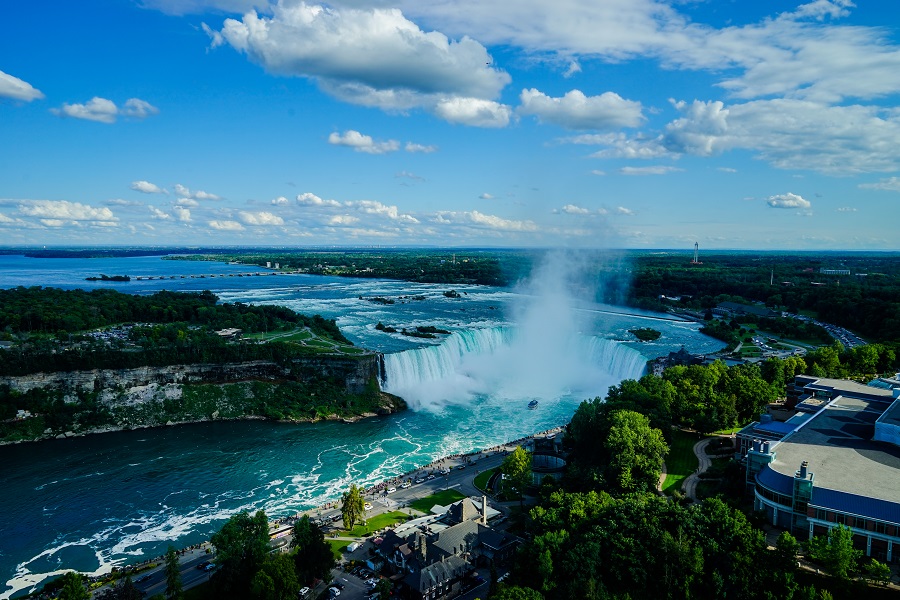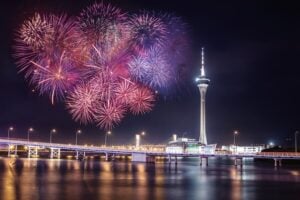A day out at Niagara Falls, Canada
What is it about waterfalls that intrigues us so? Is it the constancy that provides an antidote to the usual chaos around us? Or the awesome power of falling water that reminds us of how little we truly are? Or could it be the ultimate human desire to try and tame one of Mother Nature’s strongest forces?
Comprised of three waterfalls (The American Falls and the Bridal Veil Falls on the US side, and the Horseshoe Falls on the Canadian side), Niagara Falls isn’t the world’s tallest. That distinction belongs to Venezuela’s Angel Falls, whose drop of 3,212 feet dwarfs Niagara’s measly 110. It doesn’t have the fastest flow rate at just 85,000 cubic feet per second, compared to the astonishing 910,000 cubic feet per second of Inga Falls in the Democratic Republic of Congo. It’s not even the widest falls. Adding up all three falls, from the American extremity to the Canadian extremity, Niagara measures about 3,500 feet across – a drop in the bucket compared to the 35,376 footwide Khone Falls in Laos.

Numbers aside, there’s something simply magical about Niagara Falls that draws up to 28 million visitors a year. To uncover the secrets of the world’s most famous waterfalls, we set out to discover Niagara from every angle possible.
Nestled between lakes Ontario and Erie on the Canadian-American border, the Niagara region is home to much more than just the falls. To get an overview of this historic area once populated by native peoples and French settlers, we make our way to Niagara Helicopters for an aerial tour.
Safely harnessed into the rainbow bright helicopter, the group collectively yelps in delight as we swiftly lift off, the initial butterflies yielding to amazement as we smoothly climb higher and higher. The landscape unfolds below us as we follow the path of the Niagara River, carrying water from Lake Erie as it tumbles over the edge of the Niagara Gorge and on to Lake Ontario. Our flight path takes us over the Whirlpool Rapids and the Rainbow Bridge on our way to the American Falls and the seriously sexy curve of the Canadian Horseshoe Falls. On a clear day, it’s said you can see as far as Toronto and Buffalo, but today, we satisfy ourselves with panoramic views of the forested countryside, home to sprawling wineries, sandy beaches, and vast green spaces. At the Horseshoe Falls, we hover over the plume of mist, created as water roars over the edge and crashes into the water and rocks below, smashing into tiny droplets. The ride is only 12 minutes long, but it’s given us a thrilling glimpse into what the region has to offer.

Niagara Helicopters
The Niagara River is relatively young, only about 12,000 years old, formed from the meltwaters of the last Ice Age. A pivotal moment in its history happened about 5,500 years ago, when the waters tore through a narrow gorge, clearing out glacial debris and leaving a 90-degree bend in its wake. For a bird’s eye view of the resultant whirlpool, we board the Whirlpool Aero Car, a cable car designed by Spanish engineer Leonardo Torres Quevedo and put into operation in 1916. Held up by six sturdy cables, the 1 km-long return ride offers mesmerizing views over the tumultuous waters below as they abruptly change direction in the gorge on their way to the falls.

Whirlpool Aero Car
Since being introduced to the outside world by French explorer Father Louis Hennepin in December 1678, people have tried to conquer the rushing waters of the Niagara River by raft, barrel, boat, tightrope, and even swimming, with many losing their lives in the process. We see the power of the river up close as we stroll along the quarter-mile-long boardwalk at the White Water Walk, taking in the Class 6 rapids of Niagara’s Great Gorge. Traveling 30 mph, and creating standing waves 10-16 feet high, it’s unfathomable how daredevils have managed to make it across the deadly, deafening waters.

A much better use of Niagara’s raging water has been in generating electricity, the site of the world’s first hydroelectric power plant designed by none other than Nikola Tesla. In the so-called “War of the Currents”, Tesla’s design to generate alternating current beat out Thomas Edison’s direct current system, tapping into the kinetic energy of the Niagara River to generate electricity which could be transmitted over long distances, cheaply. “It is a monument worthy of our scientific age, a true monument of enlightenment and of peace,” said Tesla at the opening of the Niagara Falls hydroelectric power station in 1896. “It signifies the subjugation of natural forces to the service of man, the discontinuance of barbarous methods, the relieving of millions from want and suffering,”
Nowadays, up to 75 percent of the normal flow of the river is diverted through hydro tunnels to power plants that have the capacity to power nearly 4 million homes in Ontario and New York State.
To feel the full force of the Niagara River, we make our way to the base of the Canadian Horseshoe Falls, following in the footsteps of Michel-Guillaume Jean de Crèvecoeur, a French diplomat who made the first recorded descent in 1785. His journey required six hours of harrowing climbing, scrambling down boulders and sheer cliff, sometimes with the help of Indian ladders – two tree trunks notched by tomahawks. Fortunately for us, our Journey Behind the Falls required nothing more than a rain poncho and an elevator ride 125 feet down. At the bottom, we navigate the narrow 130-year-old tunnels to viewing portals cut straight through the rock revealing an impenetrable curtain of water, the sound of 681,750 gallons falling per second reverberating in our ears. At the main outdoor observation deck, the awesome totality of the falls is on full display, one-fifth of the world’s fresh water crashing down 13 stories at nearly 68 mph onto the rocks below.

Journey Behind the Falls
Before our final viewing of the falls, we detour to the gorgeous glass-domed Butterfly Conservatory. We walk the nearly 600 feet of paths through the climate-controlled greenhouse featuring ponds, tropical plants and shrubs, and even a small waterfall. However, the star attraction is the 60-odd species of free-flying butterflies which flit their way amongst the flowers and feeding stations. Opened in 1996 to educate and entertain visitors on the life cycle and habitat of butterflies, the conservatory offers a quiet respite from the crowds. Watching the butterflies leave their pupae and dry out their wings through the Emergence Window is magical, as is simply standing still amongst the 2,000 brightly-colored butterflies.

Buterfly Conservatory

For over two centuries, Niagara has hosted honeymooners, famously starting with Napoleon Bonaparte’s brother Jerome and his American bride in 1804. Nowadays, some 50,000 couples still honeymoon here every year. As the sun begins to set, we make our way to one of the most romantic spots in the area, the iconic Skylon Tower. Opened in 1965, the 775 feet-high tower features two levels of restaurants and an observation deck. The yellow elevators on the outside of the building zip us up to the Summit Suite where a gorgeous buffet dinner of prime rib, BBQ ribs, and steamed mussels await. From anywhere in the circular dining room, diners can look out over beautiful views of all three falls and beyond. After dinner, we head up to the 360º Observatory, Niagara’s highest panoramic vantage point, for a final look at the falls bathed in fading light, a wonderful way to end a day out at one of Nature’s most incredible places.

Skylon Tower
If You Go…
Niagara Helicopters (www.niagarahelicopters.com) has been offering scenic flights over Niagara for over 50 years. No reservations are needed for the 12-minute flights which operate every 10 minutes, 7 days a week, year-round. Flights are CAD 149 per adult or CAD 288 per couple, well worth it for a bucket list experience.
The Whirlpool Aero Car trip (CAD16) takes about 10 minutes, with a brief stop on the other side for passengers to change sides, ensuring everyone gets a great view of the gorge scenery. To access the White Water Walk (CAD14), take an elevator down 230 feet and walk through a 240 ft tunnel to view the rushing waters, which get their emerald green color from limestone, shale, and sandstone sediment. The self-guided Journey Behind the Falls (CAD21.95) is truly spectacular, and takes 30-45 minutes to complete, not including wait times. The Butterfly Conservatory (CAD16) is located on the grounds of the Niagara Parks Botanical Gardens (free entry), so budget some time before or after your visit to walk through the beautifully landscaped gardens. All these attractions are operated by Niagara Parks (www.niagaraparks.com). Tickets can be purchased individually, but a better idea is getting the Niagara Falls Adventure Pass Plus (CAD90) which includes entry to all of these attractions and more, as well as a hop-on, hop-off bus transportation system.
The dome at Skylon Tower (www.skylon.com) is home to a Revolving Dining Room (one revolution per hour) which serves fine dining lunch and dinner, and the Summit Suite Dining Room where the lunch or dinner buffet (CAD44.95) also includes admission to the indoor/outdoor Observation Decks.
Images by James Pham






